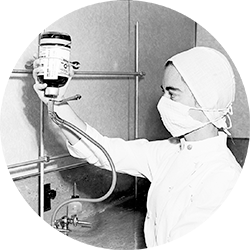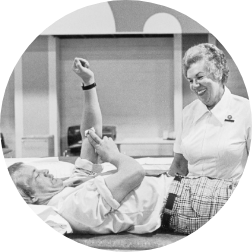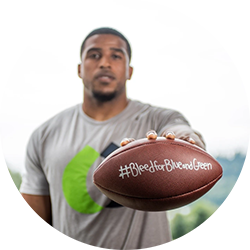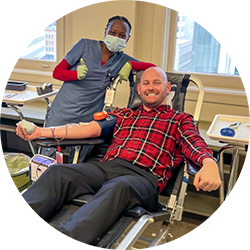Bloodworks’ mission of saving lives through excellence in blood collection, transfusion, testing, and research means that no one who needs a blood transfusion needs to go without.
80 years ago, this was not the case.
While the first blood bank opened in Chicago in 1937, most hospitals didn’t have a way to store blood. When local patients needed a blood transfusion, they either needed to hope a friend or family member had a compatible blood type and was willing to give them a pint or that the hospital could locate a paid donor and then wait for the blood to be collected and processed.
In cases of trauma or emergency, this might all happen too late to save the patient.
On May 19, Bloodworks celebrated our 80th anniversary. We reflect on where we’ve come since then, and where we’re headed.

In early 1944, amidst World War II, Seattle physician Dr. Eugene Potter estimated that 5,000 whole blood transfusions and 2,200 units of plasma were administered each year in Seattle, but the city had no centralized blood bank. The realities of war meant that a potential attack on the region from enemy forces would further strain an already inefficient system, leading to preventable casualties. Patriotic Americans were rolling up their sleeves to plant Victory gardens and get to work on the war efforts, so donating blood was no stretch.
In April of that year, King County Medical Society agreed to sponsor a plan to develop a blood bank.
On May 19, 1944, the Articles of Incorporation for Bloodworks, then called the King County Central Blood Bank (KCCBB) were filed with the Secretary of State of Washington.
Led by Dr. J. Richard Czajkowski, Bloodworks’ stated purpose was “… to collect, prepare and administer human blood, plasma, and their products for the use of the sick and injured…”
In keeping with the American tradition of local communities organizing and acting for the benefit of all, Bloodworks was created without shareholders – no one would financially profit from its lifesaving work, and all profits were to be re-invested into the organization to better realize the blood bank’s purpose, a model we follow to this day. The American Society of Clinical Pathologists gave Bloodworks recognition as nation’s lowest cost service to patients.
Despite having a centralized location for collecting, processing, and storing blood, patients in need of a blood transfusion still needed to recruit relatives, friends, or co-workers to replace the blood they used – or face a fine. With surgical advancements in the 1950s, more people than ever had the opportunity to need blood.
As researchers learned more and more about blood typing beyond the ABO blood group, compatibility testing became more complicated; Bloodworks’ centralized transfusion service performed tests to ensure patients received the best-matched transfusion for their blood type. Bloodworks also performed Rh factor tests for expectant mothers and provided hospitals with infusion sets and outpatient transfusions.
Donor Centers: Central Seattle

The 1960s and 70s were an era of upheaval, social movements, and change, and blood banking was no exception.
During this period, Seattle became the major center for testing and applying new procedures for surgery, bleeding disorders, and cancer care that it remains today – and none of these would have been possible without donate blood.
In 1960, Dr. Belding Scribner of the University of Washington Medical School introduced an artificial kidney to remove urea from blood of patients with renal failure before opening the first dialysis center in 1962; advances in kidney transplantation (and more patients living long enough to receive a transplant) increased the need for blood by 1,000 units each year – what we now need to collect in a single day.
In 1965, Dr. Judith Pool discovered that precipitate from thawed plasma was rich in factor VIII and could be cryo-preserved and infused into patients with hemophilia to stop bleeding. Dr. Rich Counts, who later became Executive Director in 1987, joined Bloodworks in 1972 to oversee a home treatment program for hemophilia patients, which grew into a robust program for hemophilia and bleeding disorders.
The first successful heart transplant was performed in 1967 in South Africa. As cardiac procedures advanced, 40 Bloodworks volunteers phoned donors continuously to fill the needs of patients scheduled for open-heart surgery.
However, Bloodworks didn’t just support this work – we were an active participant. Our Coagulation Laboratory served as a consulting center for local hospitals, helped to test patients referred by physicians, and trained technicians. 20 nurses collected blood, performed therapeutic phlebotomies, and administered transfusions.
In 1960, The addition of 1,500 square feet of lab space allowed Bloodworks to further advance blood science. Dr. Elo Giblett, who would serve as Executive Director from 1980 to 1987, discovered a new red cell antigen (the ELO antigen in her name) and wrote Genetic Markers in Human Blood. Drs. Sherrill Slichter and Lawrence Harker conducted studies that lead to a method of platelet storage widely adopted worldwide. But perhaps the biggest event of this period was a $3.5 million grant from the National Institutes of Health in 1974 to support research in blood diseases and transfusion medicine.
Technological advances weren’t limited to medicine. In 1968, the new IBM System 3 computer reduced Bloodworks’ labor costs and time spent keeping records.
While the birth control pill contributed to a “free love” mentality that spread from the hippie movement to mainstream society, hepatitis remained a concern for the blood supply. Doctors had known hepatitis was transmittable by blood since the 1940s, and isolated the virus in the late 1960s. In mid-1970, at the direction of Dr. Giblett staff begin screening all donated blood for the Australian antigen, a sign of hepatitis, using a test developed at Bloodworks — two years before a licensed, commercial test became available.
Bloodworks also expanded our commitment to providing blood for anyone in need. In 1971, Bloodworks waived the fine ($25) to patients when their blood transfusions were not replaced by a friend or family member. In 1972, we introduced our first self-contained bloodmobile, allowing us to expand our reach; previously, we had used trailers, which were difficult to park and therefore limited where we could host blood drives. Despite widespread inflation, costs associated with the blood supplied by Bloodworks remained the lowest in the country.
New Donor Centers: Bellevue, Tukwila

The 1980s and ‘90s are forever linked with HIV and the outbreak of the AIDS epidemic in the US; this era shaped policy around and perception of blood donation to the present day.
After doctors identified AIDS in December of 1981, blood centers needed to adapt to an emerging crisis to keep transfusions safe for patients and to convince the public that blood donation remained a safe activity for donors. Fear of contracting HIV from process of donating blood caused donations to drop by 8% by the end of 1983; it would take three years for them to get back up to previous levels.
Scientists knew that the virus was spread by blood and sexual activity before there was a reliable test. While it’s easy to say in hindsight that the blood banking industry should have reacted faster and more effectively to prevent transmission of HIV through blood transfusion, Bloodworks leadership made medically informed decisions that saved lives; coincidentally, Dr. Giblett discovered the first known immunodeficiency disease, adenosine deaminase (ADA) deficiency.
The Hemophilia community was particularly impacted by the AIDS epidemic.
For years, cryoprecipitate had made it possible for hemophilia patients to live longer, more active lives, and now this same treatment was killing them. Bloodworks’ Dr. Rich Counts developed a new form of treatment for hemophilia patients using a single blood donation, reducing the risk and lowering HIV transmission rate among hemophilia patients in the Pacific Northwest.
Elsewhere in the organization, Bloodworks’ clinical-care included a 24-hour consultation by physicians in the diagnosis and treatment of bleeding disorders and Outpatient Transfusion Service for ambulatory patients.
Our apheresis blood component program was the nation’s largest, with 700 volunteers in the Donor Platelet Program. In the 80s, apheresis donation involved collection out of both arms: one needle to draw blood out and the other while our therapeutic apheresis programs expand – today, this is all done out of the same vein!
Our specialized laboratories improved diagnosis and care for patients. Trustees approved the purchase of laboratory facilities in Renton for expansion of blood processing operations.
Dr. Giblett’s research supported the feasibility of stem cells to treat leukemia. Stem cell collection, processing, and transfusion began at Bloodworks. By 1999, two-thirds of stem cell transplants at Fred Hutch and Swedish Hospital used peripheral blood stems cells collected via apheresis rather than painful bone marrow donation.
Outside the organization, Bloodworks physicians as faculty comprised the largest segment of the Division of Hematology at University of Washington School of Medicine.
New Donor Centers: Vancouver, Bellingham, Olympia, North Seattle

Our Cord Blood Program ramped up in 2000. In May of that year, the Bill and Melinda Gates Foundation awarded a $1 million grant to aid Bloodworks’ Rare Blood Program and add several hundred umbilical cord samples to the Cord Blood Bank. Bloodworks still has samples from this era preserved in liquid nitrogen should they be needed!
Variant Creutzfeldt-Jakob disease (vCJD), the human version of “Mad Cow” disease, seemed everywhere in the 90s, but in reality, the outbreak was mainly contained to cattle in United Kingdom. In August, 2001, the FDA recommended banning blood donations from individuals who had lived in Britain for three or more months from 1980 to 1996 or who spent five years in Europe from 1980 to the present, a more conservative deferral than Bloodworks had previously implemented.
The terrorist attacks on September 11, 2001 were a landmark moment for blood centers across the country, as a mourning nation paid their grief forward. The lines of donors lead Dr. Counts to message staff,
Your work this week should be immensely reassuring to you, to our Board of Trustees, to our hospitals, and to everyone in our community. For you demonstrated without question that if an emergency need for a lot of blood occurs in our region, [Bloodworks] can be relied on to do its duty and to meet that need.
In 2003, the Human Genome Project had sequenced over 90% of the human genome, as close to complete as technology could get at the time. Bloodworks’ genomic testing laboratories expanded.
We had been testing and processing blood for smaller blood centers and other clients for years, and by the late 90s this operation had outgrown our original space. In the 2000s, our Renton West laboratories advanced further to accommodate growth of testing and new approaches to processing blood.
When Dr. Counts retired in 2008, Dr. Jim AuBuchon joined as President and CEO, serving until his retirement in 2019.
The 2010s saw a shift in how we served our hospital customers.
Our centralized transfusion services model now included Hemosafes —computerized “smart refrigerators”— and integrated transfusion service laboratories on-site at local hospitals, staffed by Bloodworks experts.
Bloodworks Research Institute moved to Eastlake Avenue in Seattle’s South Lake Union research corridor, doubling our work area and research capacity.
In 2015, Bloodworks Northwest and Lane Blood in Eugene Oregon merged. We had already expanded beyond Puget Sound, and now had moved into a whole new state. We opened a Portland office as we continued to support patients and hospitals in Oregon.
Bloodworks researchers discovered a “blind spot” in the commercial reagent currently being used for crossmatching. By eliminating this blind spot, blood transfusions become even safer.
In 2016, the World Health Organization declared an international public health emergency after research confirmed a link between Zika virus and congenital birth defects. Bloodworks began testing every unit of donated blood for Zika virus in advance of the deadline mandated by the FDA.
Curt Bailey, MBA, joined as President and CEO of Bloodworks in June, 2019, the first non-physician to hold this role. Instead, Curt brought to the organization a background in business and over 20 years of experience in healthcare management consulting.
New Donor Centers: Lynnwood, Eugene, Everett

In 2020, after years of serving the Cell Therapy and Transplant fields through our Cord Blood Program and other services, Bloodworks officially launched Bloodworks Bio – a comprehensive offering of products and services for our research, medical, and industry partners.
Seattle became first U.S. epicenter of the COVID-19 pandemic in March 2020. Blood donations dropped to unprecedented lows as a terrified population bunkered down within their homes.
Bloodworks acted immediately to stabilize the blood supply amid this secondary public health crisis. We added safety measures like social distancing and extra sanitation. Volunteers sewed and donated hundreds of cloth masks to our staff. Faced with the challenge of business and school closures in global pandemic, we introduced pop-up donor centers in unoccupied sports arenas and other venues.
Blood donation became welcome a way to connect with other human beings during what was, for many, a time of intense isolation.
And it worked: we collected our highest blood inventory in the last 5 years.
Bloodworks joined Blood Emergency Readiness Corps (BERC), a first-in-the-nation alliance with blood centers across the nation to ensure transfusion readiness when a mass-injury emergency strikes.
We also opened blood donation to groups who were previously barred from giving. Under FDA guidance, the “Mad Cow” deferral lifted on January 18, 2023, and following decades of advocacy, Bloodworks launched our new Individual Donor Assessment on December 6, 2023, allowing more donors than ever to donate.
New Donor Centers: Renton, Beaverton
In the past 80 years, some things haven’t changed. There’s still no artificial substitute for donated human blood, though artificial intelligence eventually may help us recruit and store these donations.
Whether Hepatitis in the 1940s, HIV in the 1980s, Zika in the 2010s, or COVID in 2020, we will continue to monitor emerging health risks and use the latest, science-backed research to make medically sound decisions around blood safety.
We’ll be opening our first Pierce County Donor Center in Puyallup in Late 2024, continuing to serve all the communities we support.
We now need 1,000 donors a day to maintain a safe and reliable blood supply in the Pacific Northwest.
We’re remain committed to providing a safe and reliable blood transfusion to anyone who needs it; this will forever remain a constant.
Tell Us What You Think!